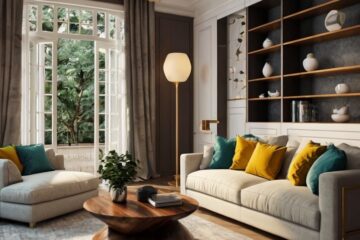Revolutionizing Spaces: Art of Retail Store Interior Design

Revolutionizing Spaces: Art of Retail Store Interior Design
Introduction: Creating Engaging Retail Environments
In today’s competitive retail market, the interior design of a store is not just about aesthetics; it’s a strategic tool to enhance customer experience and drive sales. A well-designed retail space can make shopping an enjoyable, memorable event, encouraging customers to return. This blog delves into the essentials of retail store interior design, offering insights on how to create a space that captivates and engages customers.
The Significance of Interior Design in Retail
More Than Just Decoration
Retail store interior design goes beyond decoration. It’s about creating an environment that communicates a brand’s identity, showcases products effectively, and makes shopping an enjoyable experience.
Influencing Consumer Behavior
The layout, lighting, and overall ambiance of a store can significantly influence consumer behavior, guiding their journey through the space and impacting purchasing decisions.
Key Elements of Retail Store Design
Strategic Store Layout
The layout is crucial in retail design. It should facilitate smooth customer flow and make product discovery intuitive. Popular layouts include grid, loop, and free-flow designs, each with its advantages for different retail models.
Lighting as a Design Element
Lighting in a retail store does more than just illuminate; it sets the mood, highlights products, and can guide customers through the store. Effective use of lighting, combining ambient, task, and accent lighting, can enhance product appeal and create a welcoming environment.
Color Psychology in Retail Spaces
Colors play a pivotal role in setting a store’s mood and tone. Choosing the right color palette can evoke specific emotions, influence customer perception, and reinforce brand identity.
Integrating Branding into Design
Visual Merchandising and Brand Storytelling
Visual merchandising is a powerful tool in retail. It involves creatively displaying products to attract customers and tell a brand’s story. Effective visual merchandising makes products more appealing and can communicate brand values and lifestyle associations.
Consistency Across All Touchpoints
Maintaining a consistent design theme across all touchpoints, from the storefront to the interior and even packaging, strengthens brand recognition and offers a cohesive customer experience.

Revolutionizing Spaces: Art of Retail Store Interior Design
Embracing Innovation in Retail Design
Incorporating Technology in Stores
Incorporating technology, like digital displays and interactive kiosks, enhances the shopping experience. These elements provide customers with additional information, engage them interactively, and can streamline the shopping process.
Creating Experiential Spaces
Retail is increasingly about creating experiences. Stores are introducing experiential elements like product demonstrations, interactive displays, or lifestyle setups where customers can engage with products in meaningful ways.
Sustainability in Retail Design
Eco-Friendly Materials and Practices
Sustainability is a growing focus in retail design. Eco-friendly materials, energy-saving lighting, and recycling initiatives are becoming more common, reflecting a commitment to environmental responsibility.
Green Spaces and Natural Elements
Incorporating plants and natural elements in store design can create a more pleasant and healthier shopping environment. This approach, known as biophilic design, is gaining traction in retail interiors.
The Role of Personalization
Tailoring Spaces to Customer Preferences
Personalizing retail spaces to reflect customer preferences can create more engaging and relevant shopping experiences. This can include personalized product displays, interactive elements, and tailored in-store events.
Flexibility for Changing Trends
Designing retail spaces with flexibility allows for adaptation to changing trends and customer needs. This can involve modular display systems, reconfigurable layouts, and multi-purpose spaces.
Also Read – Retail Experiences: Art of Retail Store Interior Design
The Power of Interior Design in Retail
Retail Redefined: Interior design in the retail space goes beyond mere decoration. It’s about crafting an environment that tells a story, conveys brand identity, and, most importantly, influences customer behavior. It transforms the mundane act of shopping into an immersive experience.
Shaping Customer Experience: A well-designed retail space can significantly impact customer behavior. From the moment a shopper enters, the layout, lighting, and ambiance guide their journey, subtly encouraging them to explore, interact, and make purchases.
Key Elements of Effective Retail Store Interior Design
Strategic Layout Planning: The layout is the foundation of a successful store design. It should facilitate seamless customer flow, draw attention to key products, and optimize available space. Common layouts include grid, loop, and free-form, each offering unique advantages.
Lighting Magic: Lighting isn’t just about visibility; it’s about setting the mood. Proper lighting highlights products, creates focal points, and guides customers. Different lighting techniques, such as ambient, task, and accent lighting, serve different purposes in enhancing product displays.
Color Psychology: Colors can convey emotions and affect customer perception. Choosing the right color palette aligns with brand identity and influences the shopping experience. Warm colors like red and orange can create a sense of urgency, while cool colors like blue and green promote relaxation.
Incorporating Branding into Design
Visual Merchandising: Visual merchandising is the art of product presentation. It involves creating eye-catching displays, arranging products thoughtfully, and using signage that resonates with the brand’s story. Effective visual merchandising can turn a store into a dynamic storytelling platform.
Consistency is Key: Maintaining design consistency across all touchpoints reinforces brand identity. It extends from the store’s exterior and interior to packaging and even the online presence. Consistency helps in building brand recognition and trust.
Innovations in Retail Interior Design
Tech-Savvy Shopping: The integration of technology is reshaping retail design. Interactive displays, digital signage, and augmented reality experiences are becoming common, enhancing customer engagement and providing valuable product information.
Experiential Retail: Modern retail is all about creating experiences. Retailers are transforming their spaces into experiential hubs where customers can engage with products. This can include live demonstrations, interactive installations, and immersive settings.
Sustainability in Retail Design
Eco-Conscious Choices: Sustainability is not just a buzzword; it’s a growing concern in retail design. Using eco-friendly materials, implementing energy-efficient lighting, and adopting sustainable practices not only reduce environmental impact but also resonate with eco-conscious consumers.
Bringing the Outdoors In: Incorporating greenery and natural elements into store design contributes to a refreshing and inviting ambiance. This biophilic design approach promotes a sense of well-being and connects customers with nature.
The Impact of Retail Design
Enhanced Customer Experience: A well-designed store can significantly enhance the customer experience, making shopping enjoyable and memorable. This, in turn, fosters customer loyalty and repeat business.
Boosting Sales: Effective store design can directly impact sales. By making products more appealing and accessible, a thoughtfully designed store can encourage customers to spend more time and money.
Conclusion: Designing Retail Spaces for the Future
Retail store interior design is an evolving art that plays a crucial role in the success of a retail business. It’s about creating spaces that not only look inviting but also enhance the shopping experience, reflect the brand, and adapt to changing consumer behaviors. As retail continues to evolve, so will the approaches to interior design, with a focus on customer experience, technology integration, sustainability, and personalization shaping the retail spaces of the future.
Leave a reply
You must be logged in to post a comment.









